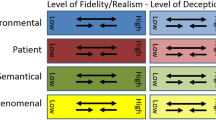Abstract
In this chapter we discuss how concepts of play and interactive story-telling can be used to make sense of simulation-based clinical education . We argue that role-playing clinical situations affects how such situations can be made sense of, because they are shaped by contemporary narrative conventions for the representation of bodily injury, and by the emotional pleasures fulfilled by mimicry and pretence. The argument has implications for interpreting the educational and ethical significance of digital, simulation technologies for representing the body, and for interpreting how such technologies introduce novel social practices—notably play —into existing institutional settings.
Access this chapter
Tax calculation will be finalised at checkout
Purchases are for personal use only
Similar content being viewed by others
References
Alinier, Guillaume. 2008. Learning Through Play: Simulation Scenario = Obstacle Course + Treasure Hunt. In Clinical Simulation: Operations, Engineering, and Management, ed. Richard R. Kyle and W. Bosseau Murray, 745–749. San Diego: Academic Press.
Bakhtin, Mikhail. 1984. Rabelais and His World. Bloomington: Indiana University Press.
Baudrillard, Jean. 1988. Simulation and Simulacra. Available here: https://epk.home.xs4all.nl/theory/Simulation/Baudrillard_Simulacra%20and%20Simulations.pdf.
Bligh, John‚ and Bleakley Alan. 2006. Distributing menus to hungry learners: Can learning by simulation become simulation of learning?‚ Medical Teacher 28: 606–613.
Cant, Robin, and Simon J. Cooper. 2010. Simulation-based Learning in Nurse Education: A Systematic Review. Journal of Advanced Nursing 66 (1): 3–15.
Bogost, Ian. 2007. Persuasive Games: The Expressive Power of Videogames. Cambridge: MIT press.
Dieckmann, Peter, Susanne Molin Friis, Anne Lippert, and Doris Ostergaard. 2012. Goals, Success Factors, and Barriers for Simulation-based Learning: A Qualitative Interview Study in Health Care. Simulation & Gaming 43 (5): 627–647.
Frissen, Valerie, Sybille Lammes, Michiel de Lange, Jos de Mul‚ and Joost Raessens. 2015. Playful Identities: The Ludification of Digital Media Cultures. Amsterdam: Amsterdam University Press.
Foucault, Michel. 1963. Naissance de la Clinique. Paris: Press universitaires de France.
Gaba, David, Steven K. Howard, Kevin J. Fish, Brian E. Smith, and Yasser A. Sowb. 2001. Simulation-based Training in Anesthesia Crisis Resource Management (ACRM): A Decade of Experience. Simulation & Gaming 32 (2): 175–193.
Gordon, P.N., S. Williamson, and P.G. Lawler. 1998. As Seen on TV: Observational Study of Cardiopulmonary Resuscitation in British Television Medical Dramas. British Medical Journal 317: 780–783.
Ip, Barry. 2011. Narrative Structures in Computer and Video Games: Part 1: Context, Definitions, and Initial Findings. Games and Culture 6 (2): 103–134.
Jacobs, Jason. 2003. Body Trauma TV: The New Hospital Dramas. London: BFI.
Ericka, Johnson. 2008. Simulating Medical Patients and Practices: Bodies and the Construction of Valid Medical Simulators. Body and Society 14 (3): 105–128.
McNaughton, Nancy. 2012. A Theoretical Analysis of the Field of Human Simulation and the Role of Emotion and Affect in the Work of Standardised Patients. Toronto: Ontario Institute for Studies in Education, University of Toronto.
Mol, Anne-Marie. 2002. The Body Multiple: Ontology in Medical Practice. Durham, NC: Duke University Press.
Murray, Janet. 1997. Hamlet on the Holodeck: The Future of Narrative in Cyberspace. Cambridge: MIT Press.
Rudolph, Jenny, Robert Simon, Peter Rivard, Ronald Dufresne, and Daniel Raemer. 2007. Debriefing With Good Judgement: Combining Rigorous Feedback with Genuine Inquiry. Anesthesiology Clinics 25: 361–376.
Sutton-Smith, Brian. 1997. The Ambiguity of Play. Cambridge MA: Harvard University Press.
Taylor, Janelle S. 2011. The Moral Aesthetics of Simulated Suffering in Standardised Patient Performances. Culture Medicine and Psychiatry 35 (2): 134–162.
Ziv, Amitai, Paul Root Wolpe, Stephen D. Small, and Shimon Glick. 2003. Simulation-based Medical Education: An Ethical Imperative. Academic Medicine 78 (8): 783–788.
Žižek, Slavoj. 1999. Is it Possible to Traverse the Fantasy in Cyberspace? In The Zizek reader, ed. Elizabeth Wright and Edmund Wright. Oxford: Blackwell.
Author information
Authors and Affiliations
Corresponding author
Editor information
Editors and Affiliations
Copyright information
© 2017 The Author(s)
About this chapter
Cite this chapter
Pelletier, C., Kneebone, R. (2017). Playing at Doctors and Nurses: Technology, Play and Medical Simulation. In: Broadhurst, S., Price, S. (eds) Digital Bodies. Palgrave Studies in Performance and Technology. Palgrave Macmillan, London. https://doi.org/10.1057/978-1-349-95241-0_16
Download citation
DOI: https://doi.org/10.1057/978-1-349-95241-0_16
Published:
Publisher Name: Palgrave Macmillan, London
Print ISBN: 978-1-349-95240-3
Online ISBN: 978-1-349-95241-0
eBook Packages: Literature, Cultural and Media StudiesLiterature, Cultural and Media Studies (R0)




